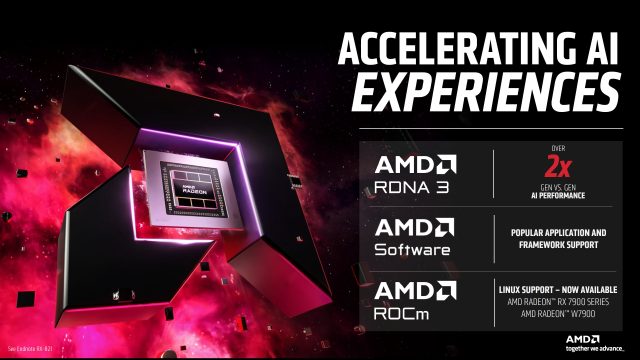AMD’s Artificial Intelligence Revolution: Radeon RX 7900 XT is 8 Times Faster than Ryzen Processors

AMD shared compelling data about the capabilities of its RDNA 3 GPU and XDNA NPU hardware in consumer-focused AI workloads. Aiming to increase the accessibility of artificial intelligence on computer platforms, AMD aims to gain superiority over its competitors.
The company is a pioneer in bringing AI capabilities to a broad PC audience with XDNA NPUs in Ryzen processors. The first NPU, introduced with Phoenix Ryzen 7040 processors in 2023, was updated with the Hawk Point Ryzen 8040 series. RDNA 3 GPU architecture also includes special artificial intelligence cores that can handle these workloads and continues its development with the ROCm software package.
AMD, In the “Meet the Experts” webinarHe talked about the optimized workloads that Radeon Graphics products like the RDNA 3 series offer gamers, content creators and developers.
The RDNA 3 graphics architecture found in Radeon RX 7000 GPUs and Ryzen 7000/8000 CPUs offers 2 times more artificial intelligence performance than the previous generation. These GPUs include up to 192 AI accelerators optimized for FP16 workloads and support many ML frameworks such as Microsoft DirectML, Nod.AI Shark & ROCm is optimized. They also have large dedicated VRAM pools (up to 48 GB) and faster bandwidth increased by Infinity Cache technology, required to process large data sets.
According to AMD, most AI use cases on the PC platform use LLMs and Diffusion models that depend on the FP16 compute and memory capabilities of the hardware they run on. Contains. Certain models such as SDXL (Diffusion) are limited in processing power and require approximately 4-16 GB of memory, while models such as the Llama2-13B and Mistral-8x 7B are limited in memory and require 23 GB. It can use up to memory.
The company states that even the $ 329 Radeon RX 7600 XT graphics card has 16 GB VRAM and offers 3.6 times more performance in LM Studio than the Ryzen 7 8700G. RX 7900 XT is up to 8 times faster than 8700G.
AMD also makes comparisons with the GeForce RTX series, which NVIDIA calls the “Premium AI PC” platform. While both series offer similar support, AMD’s 16GB GPUs are on sale at a lower price point of $329 (RX 7600 XT), while NVIDIA’s most entry-level 16GB GPU It starts at around $500 (RTX 4060 Ti 16 GB). AMD had previously demonstrated stronger artificial intelligence performance with a better value compared to Intel’s Core Ultra processors.
The webinar featured the advancement of ROCm 6.0 and its open source stack for consumer-grade hardware such as the Radeon RX 7900 XTX, 7900 XT, 7900 GRE, PRO W7900, and PRO W7800. It was explained how he received support. ROCm 6.0 supports both PyTorch and ONNX Runtime ML models and algorithms on the Ubuntu 22.03.3 (Linux) operating system and even increases interoperability by adding INT8 for more complex models.
While AMD and its ROCm suite compete against the dominant NVIDIA CUDA & TensorRT stack, Intel is also rapidly developing its own OneAPI AI stack. These three forces, which should be considered when it comes to artificial intelligence workloads on the PC platform, will offer many innovations and optimizations for current and new generation hardware in the future.

